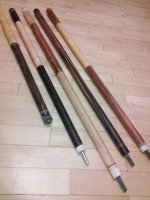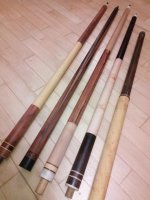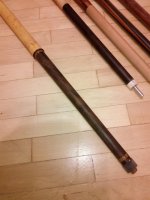Please post a correct one or a link to one.
I just did a simple search and came up with these. I don't know how accurate they are.
Specific Gravity (also referred to as "density")
Specific gravity is a simple ratio between the weight of wood and the weight of water. For instance, the typical dried weight of a cubic-foot of Hard Maple is 45 lbs. and the weight of a cubic foot of water is 62.38 lbs. To calculate specific gravity, divide 45 by 62.38 = .72
Substances with a SG of less than one will float.
We have tried to provide you with the most accurate information for the domestic and exotic wood species listed below, but there may be errors. Please use the following information as a guide. (If you find any errors in your own research, please contact us)
https://www.bellforestproducts.com/info/specific-gravity/
Spc. Gravity Specie Name
0.34 Buckeye Burl
0.37 Mappa Burl
0.38 Spanish Cedar
0.39 Guanacaste (Parota)
0.40 Anigre
0.42 Basswood
0.45 Aspen
0.45 Butternut
0.48 American Chestnut
0.51 Poplar
0.51 Tornillo
0.51 Masur Birch
0.53 African Mahogany
0.53 Koa
0.55 Quilted Western Maple
0.55 Western Maple Burl
0.55 Curly Western Maple
0.55 Western Maple
0.55 Curly Pyinma
0.55 Peruvian Walnut
0.56 Walnut
0.56 Figured Walnut
0.58 Cherry
0.58 Cherry Burl
0.58 Curly Cherry
0.58 Afzelia Burl
0.58 Ebiara
0.59 Genuine Mahogany
0.60 Figured Mango
0.61 Holly
0.62 Lacewood
0.62 Thuya Burl
0.62 Figured Makore
0.62 Quilted Sapele
0.62 Sapele
0.62 Makore
0.63 Red Oak
0.63 Curly Maple (Red Leaf)
0.63 Maple (Red Leaf)
0.63 Curly Oak
0.63 Quarter Sawn Red Oak
0.63 Spalted Oak
0.63 Nicaraguan Rosewood
0.66 White Ash
0.66 Curly White Ash
0.66 Black Ash
0.66 Swamp Ash
0.66 Amboyna Burl
0.66 Curly Narra
0.66 Narra
0.67 Honey Locust
0.67 Black & White Ebony
0.68 Redheart
0.68 Merbau
0.69 Afrormosia
0.71 Birch
0.71 Flame Birch
0.71 Birch Burl
0.72 Birdseye Maple
0.72 Hard Maple
0.72 Curly Maple (Hard Maple)
0.72 Quarter Sawn Maple
0.72 Bark Pocket Maple
0.72 Hard Maple Burl
0.72 Spalted Maple
0.72 Rift Sawn Hard Maple
0.72 Padauk
0.72 English Brown Oak
0.73 Bocote
0.73 Ziricote
0.74 Canarywood
0.74 Zebrawood
0.74 Figured Zebrawood
0.75 Red Palm
0.75 Shedua
0.76 E. Indian Rosewood
0.77 Quarter Sawn White Oak
0.77 White Oak
0.77 Madrone Burl
0.77 Mayan Walnut
0.79 Angelim Pedra
0.80 Wenge
0.80 Yellowheart
0.80 Indian Ebony
0.81 Santos Mahogany
0.81 Osage Orange (USA)
0.82 Hickory
0.82 Eucalyptus
0.83 Osage Orange (Argentine)
0.84 Bolivian Rosewood
0.84 Jarrah Burl
0.85 Olivewood
0.85 Chakte Viga
0.85 Marblewood
0.85 Red Mallee Burl
0.85 Brown Mallee Burl
0.85 Yellow Box Burl
0.86 Purpleheart
0.86 Figured Purpleheart
0.86 Goncalo Alves
0.86 Cumaru
0.86 Red Coolibah Burl
0.88 Figured Bubinga
0.88 Quilted Bubinga
0.88 Chechen
0.88 Granadillo
0.88 Black Palm
0.88 Bubinga
0.88 Tamboti
0.88 Camphor Bush Burl
0.88 Figured Camphor Bush
0.89 Amazon Rosewood
0.90 Gaboon Ebony
0.90 Mun Ebony
0.90 Spalted Tamarind
0.90 Royal Ebony
0.91 Jatoba
0.91 Leopardwood
0.91 Tulipwood
0.94 Cochen Rosewood
0.95 Pink Ivory
0.96 Bloodwood
0.96 Honduras Rosewood
0.96 Honduras Rosewood Burl
0.98 Mopani
1.00 Sucupira
1.01 Macassar Ebony
1.04 Katalox
1.04 Figured Katalox
1.04 Brown Ebony
1.08 Snakewood
1.10 Cocobolo
1.10 Kingwood
1.10 Lignum Vitae (Argentine)
1.12 Grey Box Burl
1.12 Lignum Vitae (Genuine)
1.17 Brazilian Ebony
1.19 Camatillo
1.20 African Blackwood
Janka Hardness
The Janka scale is used to determine the relative hardness of particular domestic or exotic wood species. The Janka test measures the amount of force required to embed a 0.444" steel ball into the wood to half of its diameter. Woods with a higher rating are harder than woods with a lower rating.
The scale used in the table is pounds-force.
Janka Specie Name
350 Buckeye Burl
380 Aspen
410 Basswood
470 Guanacaste (Parota)
490 Butternut
540 American Chestnut
540 Poplar
540 Mappa Burl
600 Spanish Cedar
800 Genuine Mahogany
850 Quilted Western Maple
850 Western Maple Burl
850 Curly Western Maple
850 Black Ash
850 Western Maple
891 Lacewood
930 Anigre
950 Cherry
950 Curly Maple (Red Leaf)
950 Cherry Burl
950 Maple (Red Leaf)
950 Curly Cherry
950 Tornillo
960 Peruvian Walnut
1010 Walnut
1010 Figured Walnut
1020 Holly
1055 Curly Pyinma
1100 African Mahogany
1100 Figured Mango
1160 Thuya Burl
1170 Koa
1200 Redheart
1200 Masur Birch
1210 Nicaraguan Rosewood
1220 Red Oak
1220 Curly Oak
1220 Quarter Sawn Red Oak
1220 Spalted Oak
1260 Birch
1260 Flame Birch
1260 Birch Burl
1260 Amboyna Burl
1260 Curly Narra
1260 Narra
1294 Figured Makore
1294 Makore
1320 White Ash
1320 Curly White Ash
1320 Swamp Ash
1330 Shedua
1335 Quarter Sawn White Oak
1335 White Oak
1350 Ebiara
1360 English Brown Oak
1400 Mayan Walnut
1400 Eucalyptus
1439 Quilted Sapele
1450 Birdseye Maple
1450 Hard Maple
1450 Curly Maple (Hard Maple)
1450 Quarter Sawn Maple
1450 Bark Pocket Maple
1450 Hard Maple Burl
1450 Spalted Maple
1450 Rift Sawn Hard Maple
1460 Madrone Burl
1500 Sapele
1520 Canarywood
1548 Honey Locust
1560 Afrormosia
1712 Merbau
1780 Black & White Ebony
1800 Camphor Bush Burl
1800 Figured Camphor Bush
1810 Afzelia Burl
1820 Hickory
1830 Zebrawood
1830 Figured Zebrawood
1860 Jarrah Burl
1878 Yellowheart
1900 Red Palm
1930 Wenge
1960 Bolivian Rosewood
1970 Padauk
1970 Ziricote
2010 Bocote
2020 Black Palm
2140 Sucupira
2150 Leopardwood
2160 Goncalo Alves
2200 Chechen
2200 Honduras Rosewood
2200 Honduras Rosewood Burl
2250 Chakte Viga
2318 Spalted Tamarind
2400 Osage Orange (Argentine)
2400 Santos Mahogany
2410 Figured Bubinga
2410 Quilted Bubinga
2410 Bubinga
2430 Cochen Rosewood
2430 Indian Ebony
2440 E. Indian Rosewood
2480 Tamboti
2490 Red Mallee Burl
2490 Brown Mallee Burl
2500 Tulipwood
2520 Purpleheart
2520 Figured Purpleheart
2532 Marblewood
2620 Amazon Rosewood
2690 Jatoba
2690 Olivewood
2700 Granadillo
2760 Osage Orange (USA)
2900 Bloodwood
2920 Yellow Box Burl
2960 Cocobolo
3000 Mun Ebony
3080 Gaboon Ebony
3080 Royal Ebony
3160 Angelim Pedra
3220 Macassar Ebony
3230 Pink Ivory
3330 Cumaru
3340 Kingwood
3340 Camatillo
3370 Grey Box Burl
3390 Mopani
3590 Brown Ebony
3660 Katalox
3660 Figured Katalox
3670 African Blackwood
3690 Brazilian Ebony
3710 Lignum Vitae (Argentine)
3730 Red Coolibah Burl
3800 Snakewood
4380 Lignum Vitae (Genuine)
https://www.bellforestproducts.com/info/janka-hardness/









